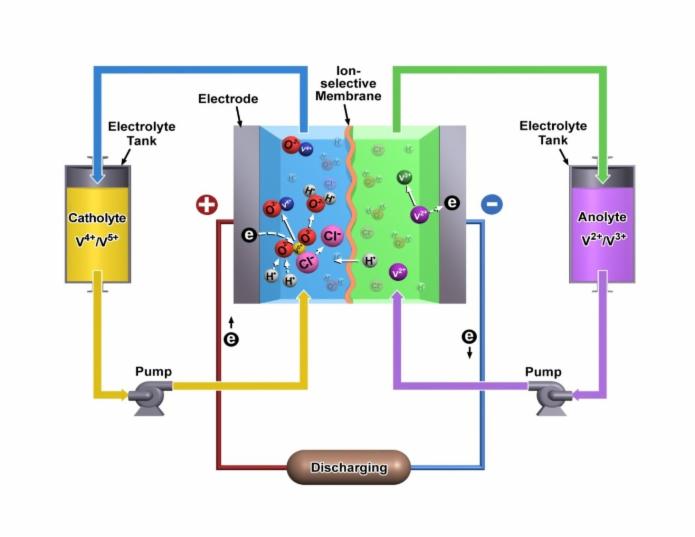Key Advantages of Advanced Vanadium Flow Battery:
- Unlimted cycles over 20 year life
- Safe - no thermal runaway
- State of Charge (SOC) agnostic
- Compact footprint
- Simple thermal management
- Incremental deployment
Working Principle and Features
The vanadium flow battery is an electrochemical battery that uses one active chemical material "Vanadium" in a flowing electrolyte that stores energy in external electrolyte tanks. Electrolyte is pumped from storage tanks through reaction stacks, electrons transfer between different ionic forms of the vanadium and chemical energy is converted into electrical energy (discharge) or electrical energy is converted to chemical energy (charge).

Cycle life
Vanadis Power’s vanadium flow battery’s cycle life can go far beyond 10,000 times or a calendar life of 20 years. This is because vanadium flow batteries use an active material that is reactive species in the electrolyte, cycling does not cause degradation to the electrodes and electrolyte. Rongke Power has advanced technology to recover eletrolyte online and it offers programs to recycle electrolyte after decomminssioning of the energy storage system.
Unlimited Deep Cycles
Vanadium flow battery can produce unlimited deep cycles with very rapid charge and discharge. Vanadis Power´s vanadium battery is less susceptible to conditions like overcharge, undercharge and partial-state-of-charge cycling that are common conditions in the utility operating environment.
Power and Energy Capacity
The unique setup of vanadium flow batteries gives them an advantage of independence between energy and power rating. The size and number of the stacks determines the power rating, the energy capacity depends on the volume and the molarity of the electrolyte. This means a vanadium flow battery System can be upgraded for more energy by expanding the volume of electrolyte, and upgraded for more power by adding cell stacks.
Wide Temperature Range for the Electrolyte
Vanadis Power’s vanadium flow battery electrolyte operates in a very wide temperature range from -40°C to +50°C, so the active thermal management system can be quite simple, since it does not have to control the temperature of the electrolyte so strictly anymore, which is an advantage over other types of energy storage systems. This does not only allow longer life for electrochemical components but is also safer to operate.